
The Digital Assets in Public Markets Forum, co-hosted by Waterdrip Capital and CPIC Investment Management (H.K.) Company Limited, with the support of Hivemind Capital, Web 3 Labs, and Stellaxis, successfully concluded on August 28 at SoHo House in Hong Kong.

At the beginning of the forum, C.G. Zhou, CEO of China Pacific Insurance Investment Management Hong Kong Limited, delivered a keynote speech, reviewing the industry's evolution over the past two years from independent development to deep integration with traditional finance, and sharing the exploration of Pacific Asset Management in virtual asset funds and RWA directions.
He introduced that Pacific Asset Management has obtained a virtual asset management license from the Hong Kong Securities and Futures Commission (SFC), establishing four funds focused on VC, secondary markets, Bitcoin, and arbitrage. In March of this year, they successfully tokenized a US dollar money market fund on-chain, utilizing the Hong Kong OFC framework, with Standard Chartered Bank as the custodian and SFC approval. In the process of promoting tokenization, Pacific Asset Management also invested in and incubated The PAC, which has now become an important technical partner in the RWA track in Hong Kong and Asia.
C.G. Zhou pointed out that stablecoins are currently the only mature RWA application, but the market overall suffers from excessive speculation and misinformation, with some projects lacking rights confirmation and liquidity conditions, which may harm the health of the industry. He called for the establishment of a professional committee for RWA to promote standard-setting and regulatory communication, emphasizing that only by maintaining calm and a long-term perspective can RWA achieve true value.

Next, John Riggins, CEO of Moon Inc. (01723.HK), delivered a keynote speech, sharing Moon Inc.'s transformation path and the strategic value of Bitcoin in public markets.
John Riggins stated that Moon Inc. originally focused on prepaid product business, but under his leadership, it is now transforming towards a "Bitcoin-first" strategy. He reviewed the successful experiences of MicroStrategy and MetaPlanet, emphasizing that the public market is the best channel for gaining exposure to Bitcoin. Moon Inc. has launched a Bitcoin prepaid card in Hong Kong and plans to expand its business to Asian markets such as Thailand and South Korea, gradually building the company into a regional Bitcoin asset carrier.
He pointed out that the Hong Kong Stock Exchange (HKEX), with its efficient and clear regulatory framework, has a unique advantage at the intersection of Eastern and Western finance, becoming an important hub for promoting Bitcoin and digital assets into the capital market. In the future, Moon Inc. will continue to purchase Bitcoin through the capital market and rely on its operational business to create long-term value. He firmly believes that Bitcoin-heavy companies will gradually emerge in major capital markets, just as MicroStrategy in the U.S. and MetaPlanet in Japan, and Hong Kong also has the opportunity to nurture representative enterprises.

The first roundtable discussion was hosted by Jademont Zheng, founding partner of Waterdrip Capital, with guests including David Zhang, founder and CEO of Boya Interactive (00434.HK), Kennix Chan, CEO of Victory Securities (08540.HK), Jack Kong, founder of Nano Labs (NASDAQ: NA) and board member of Hong Kong Cyberport, and Jackie Mung, managing director of Walnut Capital (00905.HK), discussing "Deep Dive: Insights from Operators of Listed Crypto Companies."
The guests first shared their motivations for transitioning from traditional industries to the crypto field: Boya Interactive drew on MicroStrategy's experience due to long-term undervaluation by the capital market; Victory Securities deeply realized counterparty risk after the FTX collapse, leading to a license application and transformation; Nano Labs transitioned from mining chips to a U.S. stock listing, ultimately becoming a pioneer in blockchain listings; Walnut Capital explored virtual currency payments due to cross-border settlement issues caused by the Russia-Ukraine war and established a Web 3 strategy to serve traditional industries.
During the discussion, the guests categorized the crypto concept stock model into three types: First, Treasury-type (coin-hoarding companies), which have intuitive valuations but are highly volatile; second, main business + crypto asset type, which adds Bitcoin allocation to stable cash flow to enhance valuation; third, service type, which provides compliant services such as brokerage, exchanges, and infrastructure, with the greatest long-term growth potential. David Zhang emphasized that "the real potential lies in building applications"; Kennix Chan pointed out that "in the short term, Treasury looks promising, but in the long term, compliant services are more favorable"; Jack Kong believed that "the key is to navigate through cycles and continue building"; Jackie Mung preferred a "robust path combining traditional business and crypto."
Looking to the future, the guests unanimously agreed that stablecoins, payments, and gaming are the most promising breakout scenarios, and the boundaries between Web 2 and Web 3 will gradually blur. Recommendations for traditional enterprises include: using Bitcoin as a foundational allocation, entering business through stablecoin settlements, preparing licenses and compliance frameworks in advance, and maintaining an open mindset, daring to pay tuition fees to seize long-term opportunities in the industry.
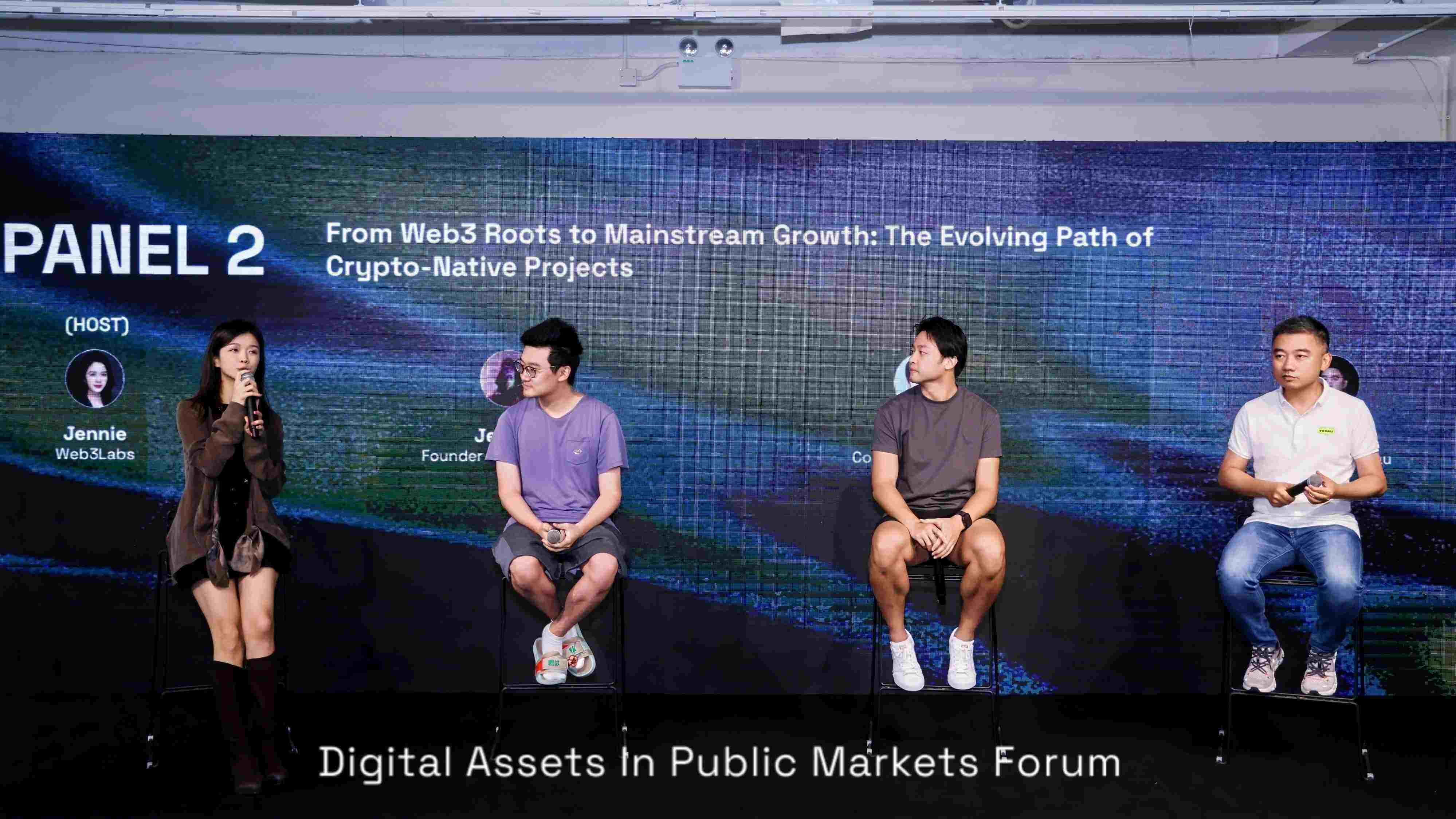
The second roundtable discussion was hosted by Jennie from Web 3 Labs, with participants including Jeff Yin, founder of Merlin Chain, Ryan Chow, co-founder of Solv, and Mac Li, founder of Tevau, discussing "From Web 3 Origins to Mainstream Rise: The Evolution Path of Crypto Native Projects."
The guests first introduced their respective projects: Merlin aims to build a BTC Layer 2 to promote Bitcoin cross-chain liquidity and DeFi applications; Solv positions itself as a decentralized bank on the Bitcoin chain, managing over $2 billion in assets and obtaining compliance qualifications in regions such as the Middle East; Tevau combines wallets with Visa cards to solve payment issues for crypto assets in the real world and has launched a Web 3 phone to lower user entry barriers.
When discussing the path for Web 3 native projects to go public, Mac Li emphasized that Web 3 companies must meet compliance and financial transparency requirements consistent with Web 2 to enter the capital market; Ryan Chow proposed a "Token-Stock 2.0" model, which combines tokens, equity, and business revenue into a triangular flywheel that will drive deep linkage between Crypto projects and capital markets; Jeff Yin pointed out that more and more U.S. listed companies are exploring cooperation with crypto protocols to achieve mutual empowerment through Bitcoin asset management and yield services.
Regarding the combination of stablecoins and Bitcoin, Jeff Yin believes that the Bitcoin mainnet and Lightning Network are expected to become important issuance scenarios for stablecoins, providing low-cost and high-security payment capabilities; Ryan Chow emphasized that Bitcoin may become the anchor asset for global stablecoins, forming a liquidity pool centered around BTC in the future; Mac Li reminded that the stablecoin ecosystem faces challenges from regulatory fragmentation across countries, and its success depends on actual use cases and the developer ecosystem.
On the development of BTCFi, the guests unanimously agreed that the industry has moved out of the early exploration phase and is entering a stage of rapid growth. Jeff Yin expects the scale of BTCFi to expand from tens of billions to hundreds of billions of dollars in the next year; Ryan Chow interpreted BTCFi from both broad and narrow perspectives, pointing out that collateral lending and Bitcoin asset management are the largest scenarios, and Bitcoin may become the main collateral asset for the younger generation; Mac Li believes that DeFi and BTCFi are essentially on-chain reconstructions of traditional finance, and future breakthroughs depend on more builders' continuous investment and innovation.
The guests finally emphasized that whether from native teams or traditional institutions, the entry points into Web 3 are different, but compliance, business models, and the spirit of builders are key to achieving long-term growth.

The third roundtable discussion was hosted by Shelley Wu, partner at Pacific Waterdrip Digital Asset Fund, with participants including Wenxin, Director of Business Development and Partnerships at Wintermute, Kevin Liu, co-founder of GOAT Network, and Sailor Zhong, founder and CEO of ChainUp, discussing "IPO on the Horizon: Targeting Public Markets for Crypto Native Projects."
The guests first introduced their business layouts: Wintermute has grown into a leading global spot liquidity provider, with daily trading volumes in the billions of dollars, and has deepened its expertise in OTC, derivatives, and institutional lending; GOAT Network aims to build a Bitcoin Layer 2 based on zero-knowledge proofs and BitVM, releasing BTC liquidity and providing native yield; ChainUp focuses on B2B trading infrastructure and asset management strategies, currently managing over $500 million in funds.
When discussing why crypto native projects seek IPOs, Wenxin pointed out that market liquidity is showing "polarization": institutional funds are concentrated in mainstream assets like BTC and ETH, while retail investors chase memes and other hot topics, leading to a constrained financing environment for quality new projects in the secondary market. Kevin Liu added that the sluggish secondary market makes it difficult for many projects to obtain incremental funding, while an IPO can provide compliance endorsement and capital strength, especially helpful for connecting with institutions like ETFs and sovereign funds. Sailor Zhong emphasized that traditional capital market valuation models such as PS and PE impose higher requirements on crypto projects, but they also bring more sustainable financing channels.
Regarding the challenges of listing crypto native projects, the guests generally agreed that compliance and auditing are the biggest challenges. Kevin Liu mentioned that Web 3 projects should focus more on growth and user scale as valuation anchors to demonstrate global expansion capabilities; Sailor Zhong pointed out that traditional markets require clear financial audits and compliance licenses, which many decentralized protocols struggle to meet; Wenxin believed that the ultimate trend is the integration of liquidity pools, as compliant products like RWA and stablecoins mature, traditional finance and crypto natives will gradually connect.
On the balance between decentralization and shareholder responsibility, Kevin Liu argued that the two are not contradictory: the underlying protocol must remain decentralized to ensure security, while the business side needs to return profits to shareholders through real users and revenue. Sailor Zhong added that currently, the projects that can truly enter the capital market are mostly stablecoins and custodial services that are closer to traditional models, while fully decentralized DeFi and DEX have yet to see successful cases.
Looking to the future, the guests unanimously agreed that the two are not "mutually exclusive," but rather "integrative and complementary." Wenxin believed this is a process of mutual embrace; Kevin Liu emphasized that BTCFi is expected to reach Wall Street and become a new narrative in the capital market; Sailor Zhong pointed out that opportunities should be viewed in light of track differences, such as the efficiency advantages of stablecoin cross-border payments, while the brokerage and exchange sectors are more suitable for traditional finance to play a role.
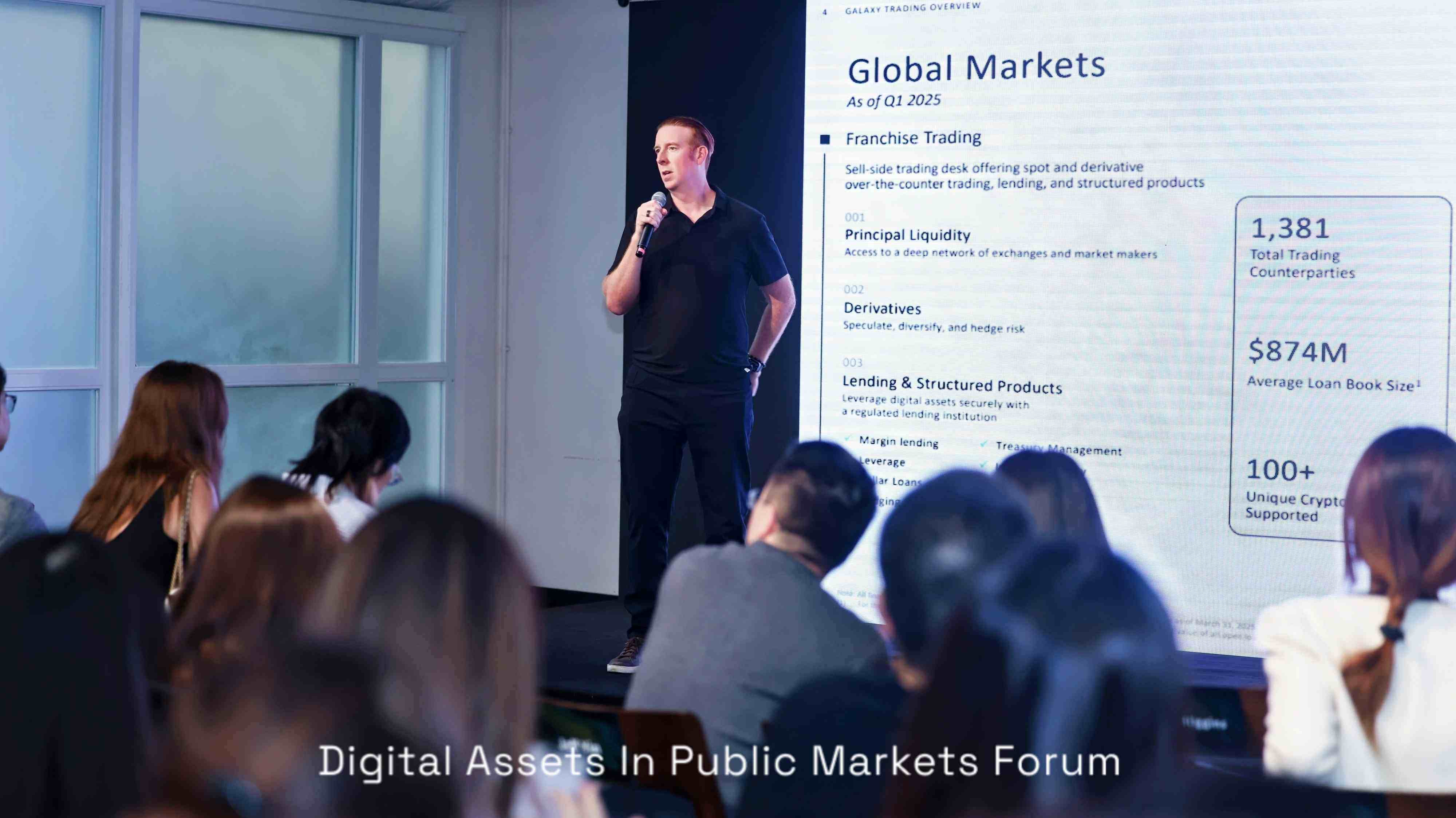
After the three roundtable discussions, John Cahill, COO of Galaxy Digital (NASDAQ: GLXY), took the stage to deliver a keynote speech, providing a comprehensive overview of Galaxy Digital's business landscape, capital operations, and industry outlook.
John Cahill reviewed his personal transition from Goldman Sachs to digital assets and emphasized that Galaxy Digital, as a leading global crypto financial institution, successfully went public on NASDAQ in 2024, with a current market capitalization of approximately $9 billion. The company's business encompasses digital asset markets and asset management, structured products and lending, investment banking and advisory, as well as infrastructure solutions. Its proprietary trading and liquidity provision scale are at the forefront of the industry, with a loan scale nearing $900 million and assets under management exceeding $7 billion, collaborating globally with traditional financial giants like Invesco and DWS to launch ETFs and ETPs.
He pointed out that Galaxy Digital's differentiated advantage lies in its full-stack service capability: it can provide clients with support for trading, hedging, staking, and custody, while also leading capital raising and investment management, forming a closed loop from strategic advisory to fund execution. Recently, the company has helped several leading projects complete financing and custody, including important participants in the Ethereum ecosystem like Sharplink and ConsenSys.
On the infrastructure front, Galaxy Digital operates validation nodes for multiple public chains, launched an institutional-grade custody solution GK 8, and actively collaborates with global regulatory bodies to promote compliance construction. John Cahill emphasized that Galaxy Digital is standing at the "intersection of Wall Street and crypto assets," and as institutional capital flows in, digital assets will gradually no longer be viewed as a separate category but will become a mainstream asset class alongside stocks and commodities.
He concluded by stating that Galaxy Digital possesses long-accumulated market experience and risk management capabilities, enabling it to maintain stability during volatile cycles and earn the trust of institutional clients through transparent and compliant operations. With the continuation of the capital raising boom, Galaxy Digital will continue to lead the institutional wave, driving digital assets into the mainstream of the global capital market.
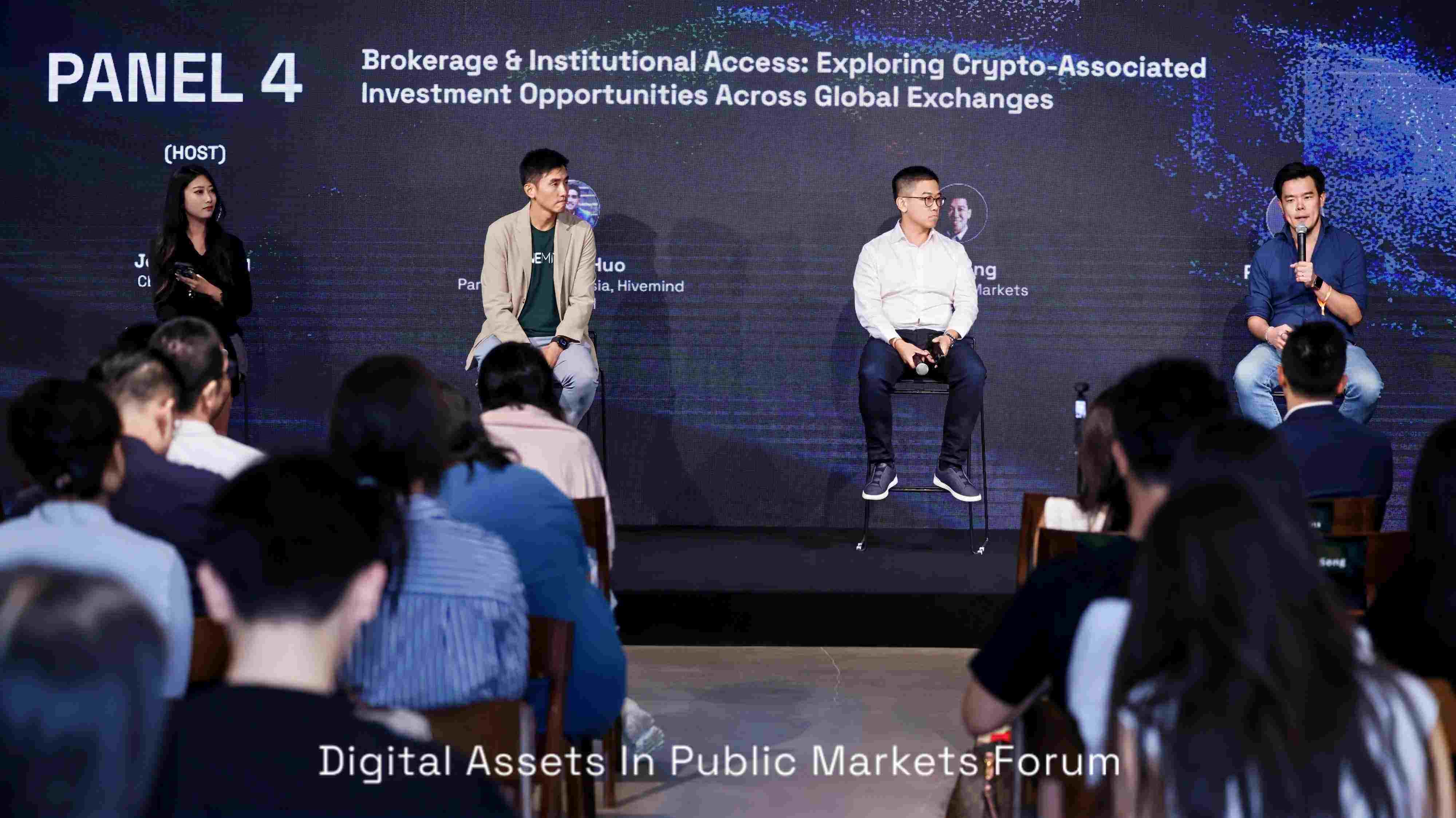
The fourth roundtable forum focused on "Brokerage Services and Institutional Access: Uncovering Crypto-Related Investment Opportunities in Global Exchanges," hosted by Joy Chen, Investment Director at Waterdrip Capital, with guests including Stanley Huo, Partner and Asia Regional Head at Hivemind Capital, Xin Song, CEO of GSR Markets, and Paolo Chen, Chief Strategy Officer at VDX.
The guests first shared their respective business layouts. Stanley Huo introduced that Hivemind is a global multi-strategy fund for digital assets, covering primary VC, secondary token trading, crypto concept stocks, and NFT investments; Xin Song pointed out that GSR provides market-making and full lifecycle financial services for over 200 projects and more than ten exchanges, gradually expanding into asset treasury and investment financing; Paolo Chen emphasized that Victory Securities and VDX are driving the development of virtual asset business in Hong Kong through compliance innovation, forming a broad institutional cooperation network from structured products to RWA and brokerage-level virtual asset solutions.
When discussing the relationship between traditional financial exchanges, crypto exchanges, and decentralized platforms, the guests generally agreed that the trend is shifting from differentiation to integration. Paolo Chen pointed out that in the future, blockchain will become the underlying settlement layer for all financial transactions, and CEX and traditional brokerages will gradually integrate; Xin Song added that tightening regulations and the entry of institutional funds will drive trading volume to concentrate on compliant platforms, while the future of DEX will depend on improvements in trading experience and custody; Stanley Huo believed that U.S. policies like "Project Crypto" are accelerating the on-chain transition of traditional financial assets, and Hong Kong and Asian markets will also benefit.
In the discussion on asset allocation and the selection of crypto concept stocks, the guests offered different perspectives. Stanley Huo believed that the emergence of ETFs and Digital Asset Treasuries (DAT) has enriched institutional channels for acquiring mainstream assets like BTC and ETH, and has increased market attention on assets like Ethereum; Xin Song emphasized that DAT stocks are popular because they expand the investment scope for institutions and retail investors, especially attracting traditional funds that can only invest in stocks or bonds; Paolo Chen categorized the tracks into "trading platforms (primarily commission-based)" and "coin-hoarding treasuries (primarily asset appreciation)," with the former being relatively stable and the latter having leverage amplification effects in bull markets.
In terms of future layouts and the outlook on "wealth codes," all three guests mentioned the enormous potential of RWA (Real World Assets on-chain). Paolo Chen believed that RWA will reshape the asset issuance and settlement chain, representing an irreversible trend; Xin Song added that true institutional investors (like pension funds) currently account for only 1-5% of digital asset allocations, focusing on ETFs as the core, with stocks and opportunistic investments as supplements, but there is significant growth potential; Stanley Huo pointed out that macro environments and policy expectations (including Trump's influence on the Federal Reserve) will affect the trends of risk assets, while mainstream assets like BTC, ETH, and Solana remain core allocation directions.
The guests unanimously agreed that as regulations clarify and market tools improve, the boundaries between traditional finance and the crypto market are being rapidly broken down, and whether in trading platforms or asset categories, the future will enter a deeper stage of integration.
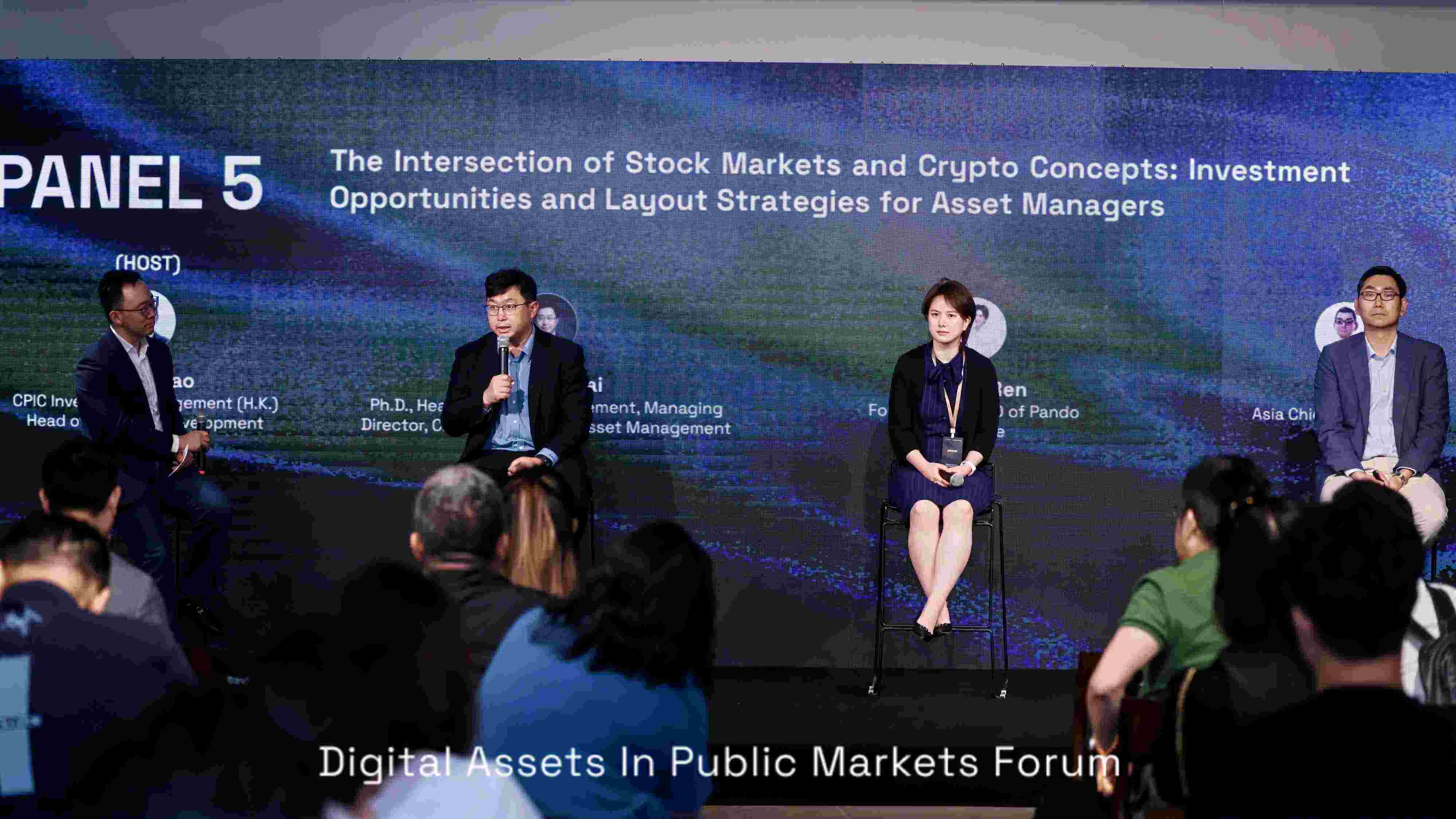
The fifth roundtable forum was themed "The Intersection of Stock Markets and Crypto Concepts: Investment Opportunities and Layout Strategies for Asset Managers," hosted by Daniel Cao, Head of Business Development at China Pacific Insurance Investment Management Hong Kong Limited. The guests included Dr. Bai Haifeng, Head and Managing Director of CMB International Asset Management, Junfei Ren, Founder and CEO of Pionex, and Xia Le, Chief Economist for BBVA Spain's Asia-Pacific region.
During the self-introduction segment, Dr. Bai Haifeng mentioned that CMB International Asset Management has, based on money market funds, taken the lead in deploying U.S. dollar money market funds onto chains like Solana, Ethereum, Arbitrum, and Plume, becoming the first multi-chain public money market fund within the mutual recognition fund system of Singapore and Hong Kong, and is actively exploring RWA practices. Junfei Ren reviewed his experiences from Huobi, ZhenFund, to Silicon Valley entrepreneurship, and introduced that Pionex has issued Bitcoin ETFs and several actively managed funds on the Hong Kong Stock Exchange, and is laying out a tokenization product line. Xia Le emphasized from a macro researcher's perspective that his research on Bitcoin dates back to 2013, focusing on the interaction between stablecoins and the international monetary system.
When discussing the investment opportunities of coin-stock linkage (DAT stocks), the guests unanimously agreed that they play a key role in connecting the crypto and traditional capital markets. Dr. Bai Haifeng categorized the participants into four types: crypto assets themselves, listed companies, convertible bonds/PIPE investors, and ordinary shareholders, believing that DAT stocks are equivalent to "automated dollar-cost averaging," lowering the investment threshold. Junfei Ren added that as exchanges, brokerages, and crypto platforms cross-pollinate, there are differences in DAT stock premiums across global markets, but in the long term, they will tend to converge. Xia Le pointed out that high-net-worth clients have strong demand for DAT stocks, but their leveraged characteristics require professional investor assessment, reflecting the "mismatch" issues in the integration process of traditional finance and the crypto market.
In terms of investment trends and asset selection, Dr. Bai Haifeng proposed three principles: prioritize regions with high market depth, focus on the financial operational capabilities of the team, and clearly identify which core crypto assets to favor. Junfei Ren emphasized that long-term fundamentals rely on the Ethereum ecosystem, while short-term performance depends on the project's financing capabilities and capital acquisition channels. Xia Le added that while DAT stocks are convenient, their core business model still revolves around financial risk management, and the risk contagion effect must be approached with caution.
Regarding risk points, Dr. Bai Haifeng warned to be cautious about whether blockchain performance can handle extreme trading volumes, the uncertainties brought by over-reliance on political cycles, and the potential for a bubble process. Junfei Ren used the "impossible triangle" as an example to point out that decentralization, efficiency, and cost cannot be achieved simultaneously, and applications need to vary by scenario. Xia Le further emphasized that DAT stocks need to strengthen risk management; otherwise, there may be cross-market risk contagion during the integration of finance and crypto.
In terms of business and product layout, Junfei Ren pointed out that Pionex not only issues crypto-related ETFs in Europe and Hong Kong but is also promoting the tokenization of traditional assets to meet the strong market demand for the tokenization of U.S. Treasuries and stocks. Xia Le emphasized that traditional institutions can meet investors' allocation needs for DAT and RWA through fund-based and centralized solutions.
On the topic of stock tokenization, Dr. Bai Haifeng used the history of ETFs as an example, pointing out that the current on-chain trading lacks sufficient market-making and arbitrage mechanisms, which may lead to long-term price dislocation. Junfei Ren believed that the enormous market demand will accelerate the implementation of stock tokenization, and that in the future, it will be more promising for listed companies to directly acknowledge a model where on-chain tokens are bound to stocks one-to-one. Xia Le took a cautious stance, arguing that 24/7 trading does not necessarily enhance market efficiency, and that the depth and stability of financial markets are more critical.
The three guests concluded that the linkage between crypto and stocks, as well as stock tokenization, are still in their early stages, but they reflect the accelerating integration of traditional capital markets and crypto finance. For institutions, it is essential to seize new asset allocation opportunities while placing a high emphasis on risk control and the construction of market mechanisms.
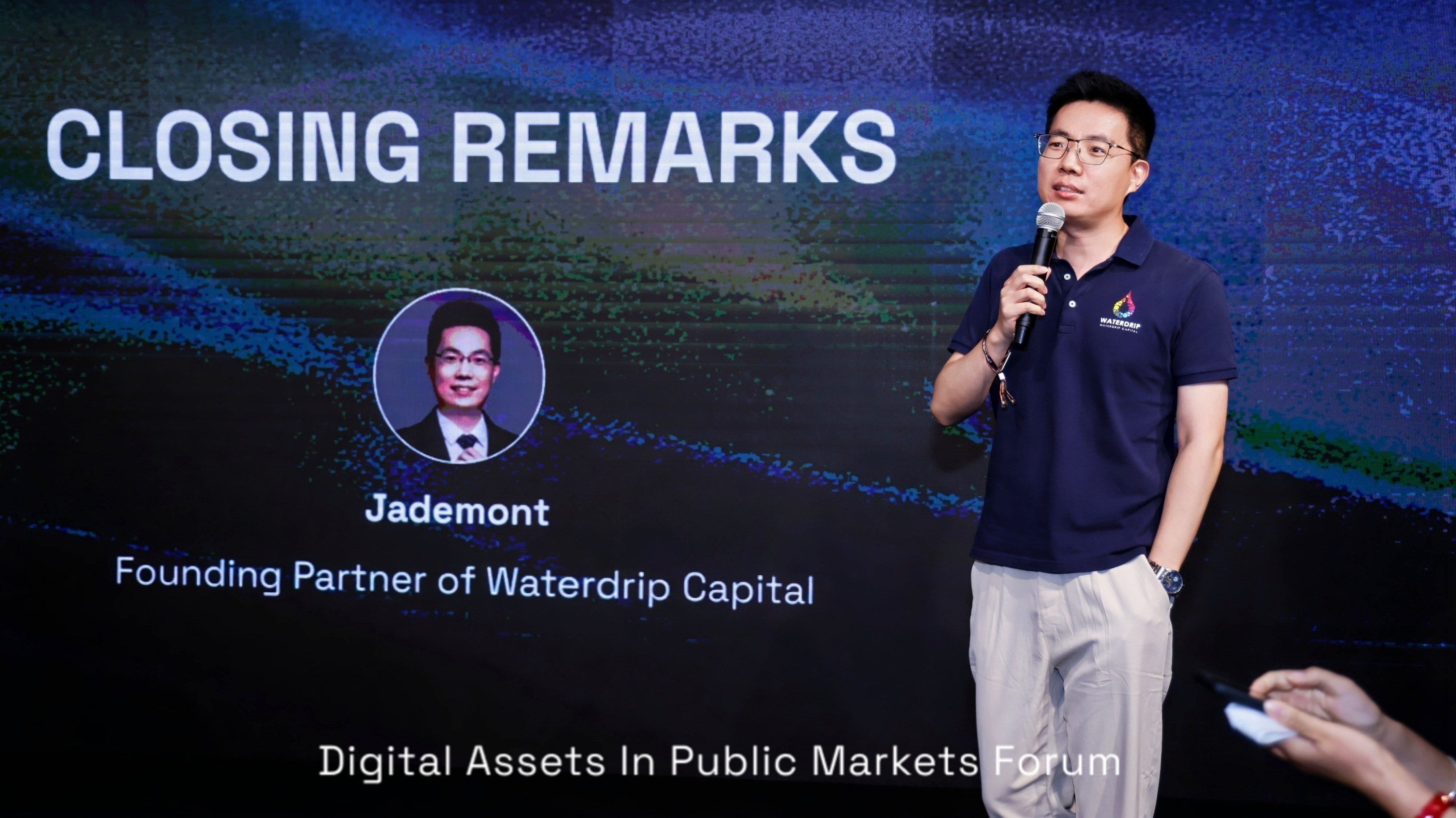
Finally, the closing segment of the crypto public company forum was held. Jademont Zheng, founding partner of Waterdrip Capital, took the stage to deliver a speech.
In his closing remarks, Jademont Zheng stated that this conference was a true celebration of the "deep integration of the crypto world and traditional finance": it featured early entrepreneurs from the Bitcoin ecosystem sharing their experiences in decentralization and native crypto, as well as international investment banks and asset management institutions providing in-depth analyses of the crypto industry from macro, capital market, and compliance perspectives. Jademont Zheng emphasized that the intersection of these two major systems on the same stage is a microcosm of the industry's development trend, and he expressed gratitude to all the guests and audience for their participation.

After the closing speech, guests and audience members moved to the second floor to participate in an immersive digital art experience. The art exhibition "Code & Collect: From Patterned Beginnings to Tides of Worth," curated by Stellaxis founder Stella Miao, showcased the remarkable works of internationally renowned artists, including Rui Huang, Ting Song, Henry Chu, Tyler Hobbs, Beeple, Refik Anadol, and several pioneering creators from Larva Labs. The exhibition explored the intersection of technology and art through diverse visual languages, providing a cross-disciplinary immersive experience that presented and discussed the organic combination of art culture and digital assets, as well as the significant value of digital art as an indispensable part of the future Web 3 ecosystem.

免责声明:本文章仅代表作者个人观点,不代表本平台的立场和观点。本文章仅供信息分享,不构成对任何人的任何投资建议。用户与作者之间的任何争议,与本平台无关。如网页中刊载的文章或图片涉及侵权,请提供相关的权利证明和身份证明发送邮件到support@aicoin.com,本平台相关工作人员将会进行核查。



